STFU
January 9, 2007 General 3 CommentsNo particular motivation for this, but it’s probably something everyone in free software (and IT in general) should re-read every 6 months or so: An open letter to other men in the movement by Dan Spalding.
No particular motivation for this, but it’s probably something everyone in free software (and IT in general) should re-read every 6 months or so: An open letter to other men in the movement by Dan Spalding.
One of the most controversial blog posts I’ve written here hasn’t been about software, it’s been about French property prices.
I recently bought some shares (for the first time) and following share prices has caused me to think about why investing in property is such an attractive proposition.
The answer is leverage.
The way leverage works is simple – if I invest €100 of my own money into something, and it goes up in value by 5%, I make €5, or a 5% return on investment. If I invest 10 euros of my own money, borrow €90, it goes up 5%, and I reimburse €92, I’ve made €3, or a 30% return on investment.
Mortgages work the same way – if I buy an apartment for €150,000 and resell it for €200,000, then the more I have borrowed from the bank, the greater (in percentage terms) my return on investment.
Investments which go the other way also magnify the effect – in that initial example, if I put €10 of my own money, and I lose 5%, when I’ve paid back €92, I’m left with only €3, a loss of 70% of my capital. I can also end up in debt if the investment loses any more than 8% of the initial value.
How do people get leverage for investments other than the property market? I have no idea. I would love to find out, though. Anyone have any tips?
After yesterday’s post, I went looking for one of those area-preserving maps I mentioned. Aside from the usual spherical and sinusoidal projections, I found out about the Dymaxion projection.
It’s an invention of Buckminster-Fuller, also famous for designing the Geodesic dome, and the Buckminster Fuller sphere (commonly known as the Bucky ball), which is now the classical geometry used for footballs, and who gave his name to the Carbon allotrope Buckminster-Fullerene (or C60) which has the same structure as the Bucky ball.
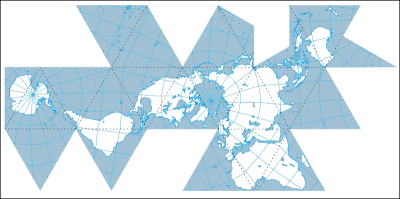
The globe is mapped onto an icosahedron, which almost eliminates distortion, and then unfolded to a planar surface. One interesting characteristic of the projection is that it’s possible to unfold the shape so that the continents are almost contiguously connected.
The other interesting thing is that once unfolded, it becomes obvious that Australia and Africa have almost exactly the same shape.
Recently, I’ve been seeing a bit more of the world – in recent months, I’ve been to Brazil and Portland, and over the next few months, I’ll be in LA, San José, Brussels and the UK, and probably more.
So now I get to answer questions from my eldest son Thomas like “Is Brazil near school, Daddy?” – I’ve come to realise that Thomas has no sense of the scale of the world.
So I decided to make the boys a globe light.
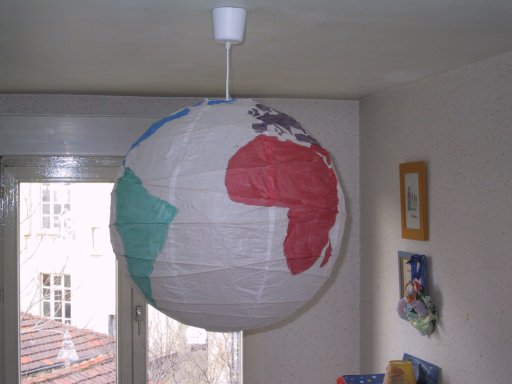
I bought a cheap paper ball light from Ikea and printed out a decent sized map of the world, drew some pencil guide-lines around the tropics, the equator and the arctic circle, and I was off.
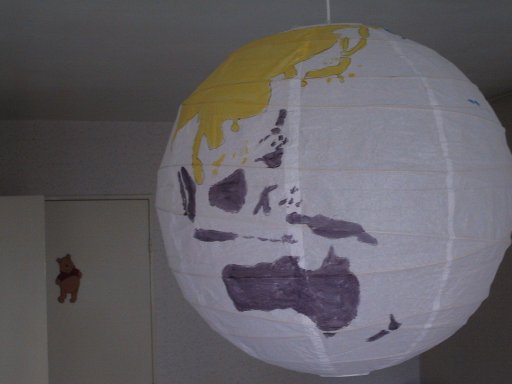
One of the things you learn when drawing a map is how little land is below the equator. The really interesting bits are at the top – so much so I almost hung the world upside-down just to see what it would look like.
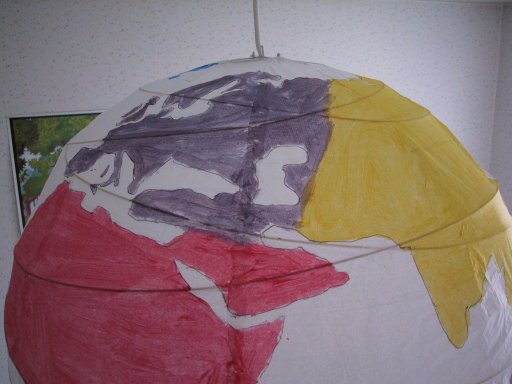
Another of the things you learn is that you will always draw the bits of the world you know better than the rest (see Europe). Australasia in particular is a pain to draw – what with Japan, Malaysia, the Philippines and Indonesia, it’s just a bunch of these tiny interlocking islands.
Also of note are some controversial colouring decisions – Turkey is in Europe on my globe, and part of Malaysia is in Australasia, while the rest is in Asia. No need to write in about these – they were simply convenience decisions on the spur of the moment.
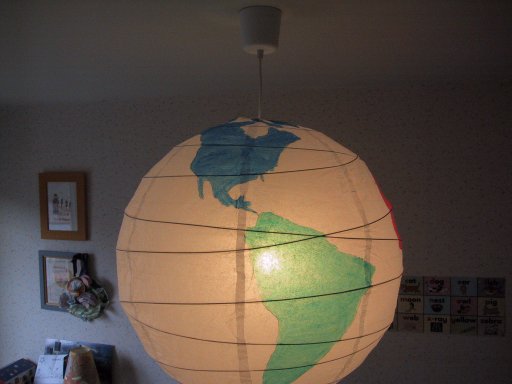
Another thing you notice when you try to draw things to scale is how stretched Europe and the US are in our classical world maps. I know that there are map types which preserve area, but I guess that we don’t use them much because people aren’t comfortable with how small Europe is.
This evening, Lyon celebrates the release of Firefox 2.0.
The party starts after 18h, in the Cavern, 11 rue des Trois Mariés – a new pub in the Vieux Lyon run by a Paddy, a Frog and a Canuck. So if you’re in the area, come along, there’s wifi, darts and maybe some beer.
Pour ceux qui ont vu ma présentation la semaine dernière, et qui n’ont pas reconnu le visage (ou qui l’ont reconnu, et qui se sont amusés à voir mon trou de mémoire): Blake Ross.
The cynic in me agrees with Damon Hill’s analysis that Schumacher will go into the Brazilian grand prix trying to figure out how he can manage to score 10 points without having Alonso score any. Here are two scenarios which have come to mind.
Oh – and Calum, I’ll thank you not to mention the weekend’s international football.
Michael: Try ‘svn cp -m “Creating a tag/branch” . svn+ssh://server/directory/tags/test_tag’
I have know Rob Levin through OPN and Freenode for nearly 10 years. He was committed to his vision of freenode as a place for free software projects to interract, and provided a valuable service to many projects. I know that his efforts to fundraise by broadcasting on the network annoyed some people, but so be it. Rob gave so much to the cause of free software, his influence will be felt for years.
The last thing I want to have to do on a Monday morning is read of the death of someone I knew and respected, so it was a shock to read this morning that Rob died over the weekend after being seriously injured in a road acident last week. My thoughts go out to his family. Goodbye Rob.
Mike, if you hear about this, your eclipse.org address is blocking my mail with a blacklist.
Can you mail me from an address that doesn’t use them, so that I can ask you a question, please?